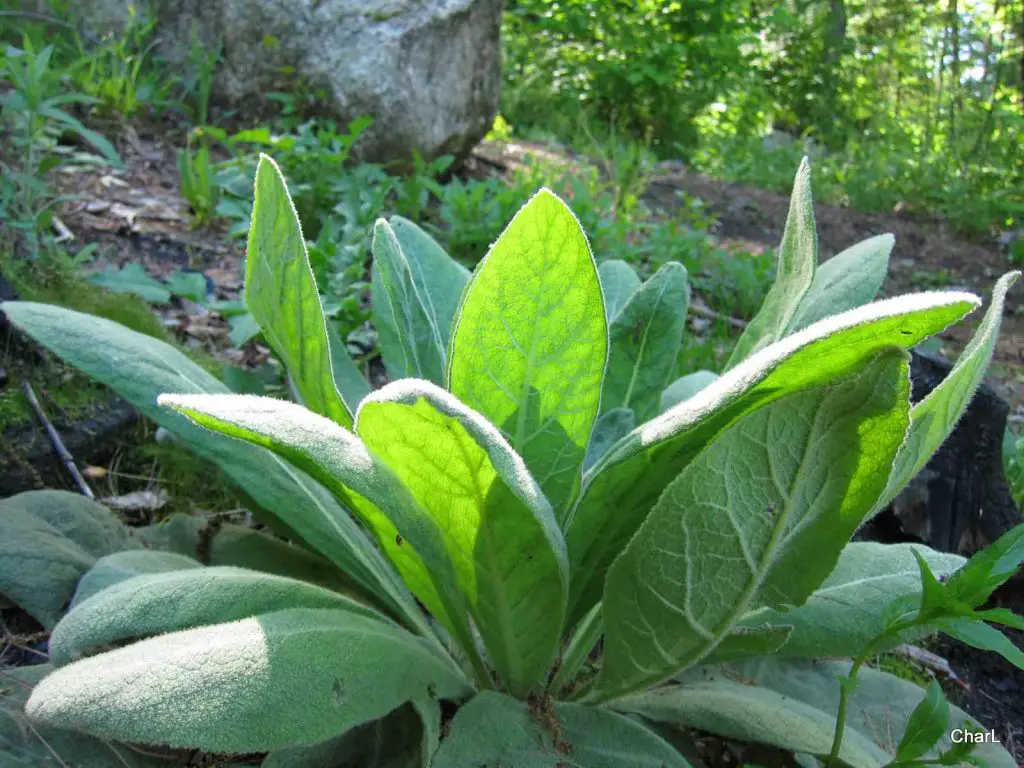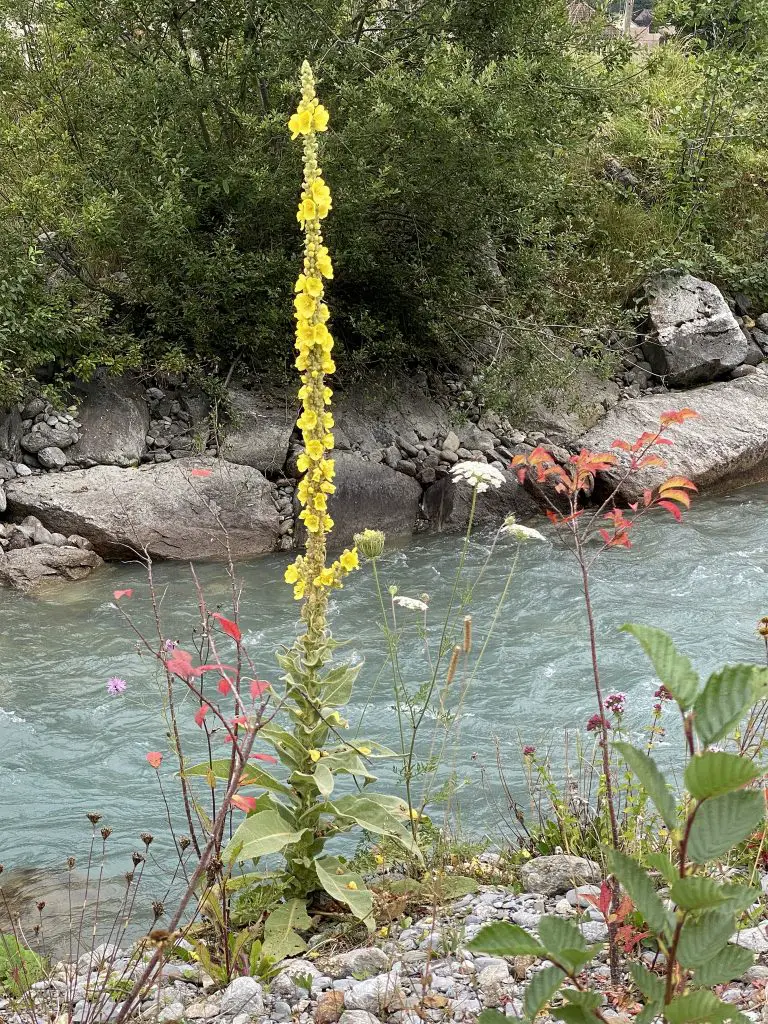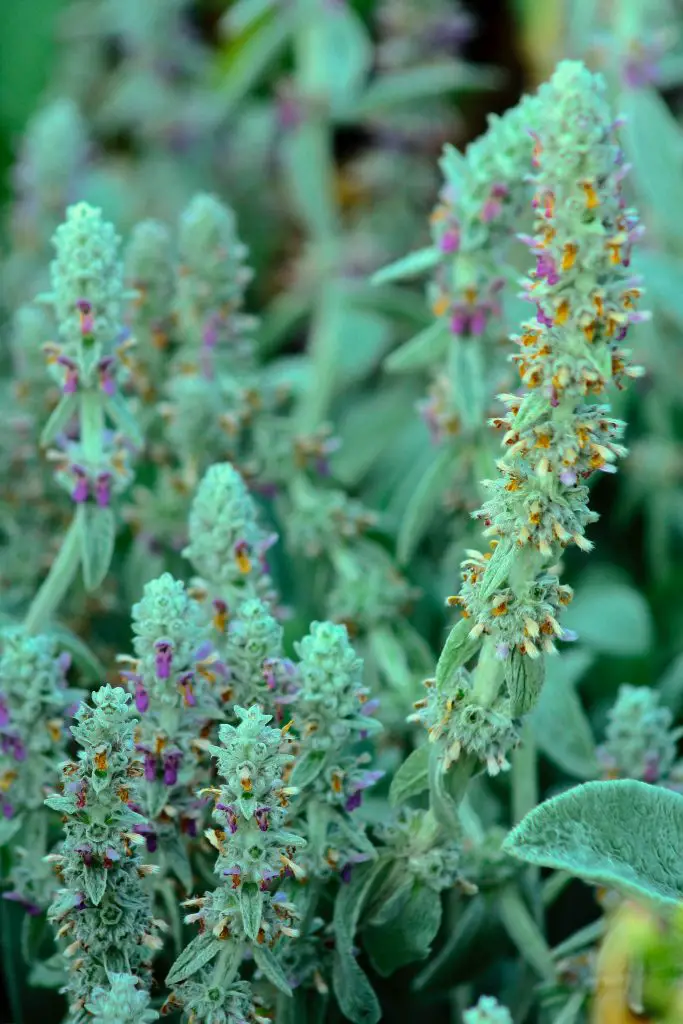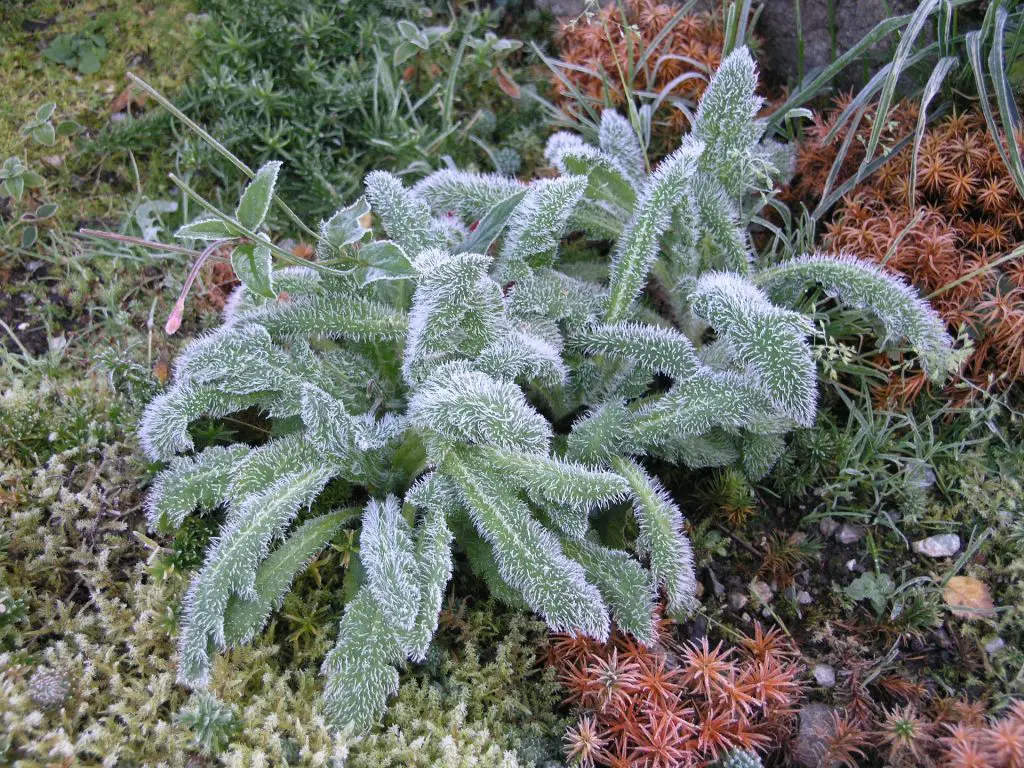What Is The Difference Between Lambs Ear and Mullein? Lamb’s ear and common mullein are two very similar plants. They both have greeny grey foliage that has a soft fur on the surface that makes them look extremely similar. Are these just different names for the same plant?
Despite their similar appear Lamb’s Ears and Common Mullein are not closely related species, they come from separate plant families. Common mullein is a biennial plant that resembles Lamb’s Ears, a perennial plant, in the first year only. In the second year, it produces a 6 to 7 ft flower spike before dying off. An image of the Common Mullein in year 1 and year 2 when it is in flower is shown below.


Whereas the Lamb’s Ears is a perennial plant that remains low growing throughout its lifetime and periodically produces purple flowers rather than the yellow of the Common Mullein. See the image below.

It is also important to note that the term Mullein actually refers to an entire genus that has a range of different species whereas the term Common Mullein refers to the specific species Verbascum thapsus. It is also known as great mullein or greater mullein and is native to Europe, Northern Africa, and Asia.
The plant grows in a wide variety of habitats but prefers sunny locations where the soil has been disturbed. Also as it seeds prolifically it has been classified as an invasive weed in many temperate regions.
About Mullein
Verbascum is a genus, which is sometimes referred to as Mullein, that contains over 400 species. They are biennial or perennial plants main and they typically grow to up to 10ft tall (3 meters). In most cases, the plant typically forms at rosette of leaves and then subsequently uncoils long stalks loaded with dense flowers that are yellow, red, purple, or white flowers.
When these plants are in flower there form is reminiscent of foxgloves. However, the advantage that they have over fox gloves is that they are not poisonous. Mullein has been used by Native Americans to help with a variety of different ailments.
The leaves and stems of the mullein plant can be chewed to relieve pain in the mouth and throat, and they can also be used to clean open wounds. Mullein has also been used to treat respiratory problems, including asthma, bronchitis, and whooping cough.
The best way to make use of the medicinal benefits of mullein is to harvest leaves and the stems of the plant in the early summer. The leaves can be crushed and used as a poultice directly on a wound, or they can be brewed as tea that can be used to drink or to wash a wound.

How To Grow Mullein Plants
Mullein plants can be grown easily using seeds though you’ll want to take care in where and when you plant them, as some varieties of mullein can be invasive in your garden and surrounding landscape as mentioned above.
How To Plant Mullein Seeds
The seeds of mullein are best sown indoors in the early spring so that they may be transplanted outside around the time of the last expected frost, which is usually early June in most parts of the US.
Mix mullein seeds in the top layer of soil as light is required for germination so scatter the seeds evenly over growing media and stir gently. To ensure a constant supply of moisture to the seeds and reduce any accidental pockets of air, simply press down the growing media to allow contact between the germinating seeds and the damp growing medium.
Mullein shoots may not be quick to germinate and can take as many as 20 days just to emerge. So if they are slow to emerge don’t worry as the plants’ seeds have the ability to retain their integrity for as long as 100 years.
Once the plant reached a reasonable size they can be planted out into the garden at a spacing of at least 1 ft (30cm) to allow them room to grow. The plant ideally should be planted in full sun and will grow well in most soil even poor ones.
The one exception to this is heavy clay-based soils as the plant does not like wet feet, so don’t overwater them. In terms of soil pH Mullein grows best in alkaline conditions so if the soil is acidic and the plant is struggling add some lime.
As the plant readily self sows it import to regularly remove any unwanted seedlings that appear to ensure that the plant does not take over your garden.
About Lamb’s Ears
The Lamb’s Ears unlike the Mullein is a single species, Stachys byzantine that is a member of the Lamiaceae (or Mint) family that is native to the middle east. It is a popular ornamental plant that is widely used in cottage gardens.
Lamb’s Ear is a perennial plant with a fuzzy, soft, velvety, silver-white coating on the foliage. The plant produces small, light purple flowers in late spring and early summer.
The flowers are small and light purple that sit on top of erect flowering stems that are usually 2 ft tall (60cm). The plant is quite drought tolerant but can also die back during cold winters but the plant will generate new growth from the crowns when the warmer weather returns.
How To Grow Lamb’s Ears
Lamb’s Ears is a relatively easy plant to grow that performs well in full sun or light shade in well-drained soils. The plant is also tolerant of poor soil conditions as it is relatively drought-tolerant and is ideally suited as an edging plant particularly near walkways where it can be extremely hot in summer.
It also spreads due to self-seeding though not to the same extent as Mullein. The plant also expands in size naturally via the root system which makes it a good ground cover. It will grow happily in hardiness zones 4 – 10.
The best time to sow Lamb’s Ear seeds is in late winter. It’s best to keep them inside and near a bright window as they need lots of sunlight. Alternatively, you can use a heated propagator, which will ensure that the seeds have the ideal conditions for growth.
The one we recommend is the iPower Heating Seed Starter Germination Kit, shown in the picture below largely because it has a vented humidity dome and is relatively inexpensive. Click on the link to see the current price on Amazon.

To plant Lamb’s Ear, sprinkle the seeds onto the surface of the soil, and ensure that they remain moist until the seeds germinate. The germination rate and the growth of the these plants is typically slow and the plant will require at least 6 to 8 weeks in the pot before they are large enough to be transplanted into the garden. When placed in the garden they need to be spaced at a distance of 18 to 24 inches (45cm to 60cm).
When planting them into the garden choose a location that receives full sun or light shade. In terms of soil conditions ideally, the soil should be well-drained and nutrient-rich however while this is the preferred conditions Lambs Ears are generally quite forgiving and will tolerate a range of soil conditions.
Once established these plants require very little maintenance. However, to ensure that the plants remain looking good ensure that any damaged leaves are removed. Additionally, as the plant spreads over time it will be necessary to divide the plant periodically to prevent overcrowding. This usually only needs to be done every 2 to 4 years or so.
Popular cultivars of lamb’s ears are Stachys byzantina ‘Helen von Stein’ or ‘Big Ears’ which have attractive and fragrant foliage and Stachys byzantina ‘Silver Carpet’ with incredibly attractive silvery-green leaves. Both cultivars rarely bloom but provide excellent ground cover.
Related Articles
Is Lamb’s Ear A Succulent? If Not What Is It?
Are Foxgloves Poisonous? Can You Touch Them?
Are Calendula And Marigold The Same Thing? (How Do You Tell The Difference?)
Are Hollyhocks Poisonous? Can I touch Them?
